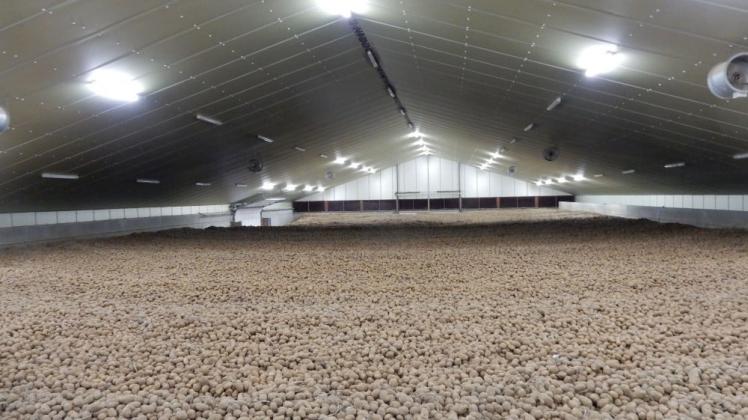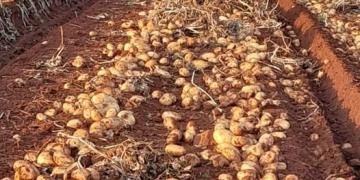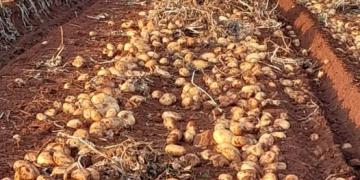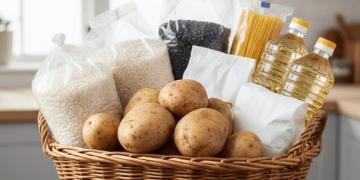Europe: Causes that explain the serious potato crisis in 2025
The potato growers’ association NEPG issues a very direct warning to farmers: are they prepared to continue producing potatoes while incurring significant losses?

The statement warns of an economically unsustainable situation, marked by plummeting free prices – between €0.50 and €4.00/100 kg depending on country, variety and quality – and by the already explicit announcement from the processing industry that both prices and contracted volumes for the 2026-2027 campaign will decrease .
All this in the context of a record harvest in the NEPG area (Belgium, Germany, France and the Netherlands), where total production in 2025 is estimated at 27.2 million tons , 10% more than in 2024.
See morePope InformationQuote historyCertified potato seedspotatotablePest control suppliesSolanum tuberosumFertilizers for papayaGardening toolsSpecialized agricultural machineryFaced with this scenario, the fundamental question posed by the NEPG is as simple as it is uncomfortable: can producers afford to maintain the same potato acreage without jeopardizing the economic viability of their farms?
A market under strain: plummeting prices and increased supply
The statement emphasizes that "free buy" prices (potatoes sold outside of contracts) are at historically low levels, between €0.50 and €4.00/100 kg , with virtually no buyer interest. In other words, potatoes are available, but the market doesn’t want them, or only wants them at prices that don’t cover costs.
At the same time, the industry has announced that it will reduce both contract prices and contracted quantities for 2026-2027. This means that the producer faces a double blow:
- Fewer potatoes sold under contract (where there is usually greater stability).
- Lower prices per ton contracted.
In this context, the risk of a large part of the harvest being exposed to the open market—where prices are already depressed—is very high. NEPG itself sums up the situation with a stark statement: “Only the strongest will survive.”
A record-breaking 2025 harvest: +10.4% production
The table included in the press release clearly reflects how this scenario has been reached. In 2025, total production in the NEPG area reaches 27,242,000 tons , compared to 24,683,000 tons in 2024; an increase of 10.4% year-on-year .
Compared to the average of the last five years (23,137,000 tons) , the 2025 production is a staggering 17.7% above that average. The problem, therefore, is not merely a temporary situation compared to 2024; it is that far more potatoes have been produced than usual, even from a multi-year perspective .
More hectares and better yield: the perfect cocktail for an oversupply
See moreAdvertising on the portalLo Valledor Market AnalysisCentral Market of Buenos AiresAgricultural work clothespotatoDollar/Euro exchange ratesOnline advertisingPope’s QuoteProcessed potato foodsEconomic news about potatoesThe increase in production is not accidental. The NEPG details three key agronomic factors:
Increased area : The total area in 2025 rises to 608,062 ha , compared to 569,216 ha in 2024; a 6.8% increase . Compared to the five-year average (524,488 ha), the increase is 15.9% . Improved planting conditions : Early sowings were carried out under good conditions , which favored crop development. Higher yields : The average yield of NEPG increases from 43.2 t/ha in 2024 to 45.2 t/ha in 2025 , a 4.5% increase. This also exceeds the five-year average (44.3 t/ha).The end result is a classic in agricultural markets: more land × more yield = much more production , just at a time when international demand is slowing down.
China and India surge in frozen potato exports; the EU-27 loses ground
The statement highlights a significant structural shift in the global frozen french fry market. In the last two seasons, China and India have increased their frozen potato exports to neighboring countries tenfold , now exceeding 500,000 tons combined .
Meanwhile, exports from the EU-27 have seen two consecutive seasons of decline . The NEPG cites several factors that reduce the competitiveness of European industry:
- “Trump tariffs” that make it more expensive for European products to enter certain markets.
- The strength of the euro against the dollar reduces the price competitiveness of European exports.
- Rise of new processed potato producers (China, India, Egypt, Turkey and other emerging countries in the frozen french fry segment).
In other words, not only are there more potatoes in Europe, but the export market is becoming increasingly difficult and is being taken over by new players.
Country-by-country overview: Belgium, Germany, France, and the Netherlands
The NEPG table allows for a detailed comparison of the evolution by country, both in production and in area and yield. Below is an analytical transcript in Spanish , focusing on 2024 and 2025 and comparing it with the averages of the previous five seasons.
See moreEfficient irrigation systemsCentral Market of Buenos AiresAdvertising on the portalInternational Prices of PotatoesPope InformationQuote historyEconomic news about potatoesPotatoPest control suppliesAccess to market dataNEPG 2024-2025 comparative summary (production, area and yield)
- France is the country furthest from its five-year average, with 2025 production 23% higher and a planted area 22.7% larger . However, its yield remains virtually flat (-0.2% compared to 2024).
- Belgium and the Netherlands combine significant increases in area with a strong leap in yield , which boosts production (+15.0% and +13.7% in 2025 compared to 2024, respectively).
- Germany shows more moderate growth, but its production is still 16.6% above the five-year average , with advances in both hectares and tons per hectare.
Visual representation of the crisis
- 27.2 million tons of potatoes in 2025 in the NEPG.
- +10% production compared to 2024; +17.7% above the five-year average .
- 608,000 hectares sown , a +6.8% increase compared to the previous year.
- Average yield of 45.2 t/ha , a +4.5% increase compared to 2024.
- Free market prices between €0.50 and €4.00/100 kg , with hardly any commercial outlet.
- Frozen potato exports from China and India have increased tenfold in two seasons, exceeding 500,000 tons , while the EU-27 has reduced sales for the second consecutive year .
Reduce surface area or accept losses?
The NEPG’s conclusion is clear: in the short term, there are no signs that the competitiveness problems of the European potato chip industry will be resolved . With depressed prices, high costs (including high land rents ), and increasing international competition, producers must assess whether it makes sense to continue planting the same acreage .
The statement invites each farmer to ask themselves an uncomfortable but essential question:
"Can they afford to lose money producing potatoes at the same scale as before?"
Ultimately, the decision hinges on recalibrating the planted area , reviewing costs, renegotiating contracts, and evaluating alternative crops or diversification strategies. In an increasingly globalized and volatile market, the 2025-2026 season could mark a turning point for potatoes in the NEPG region.
Fuente: agronewscastillayleon.com




